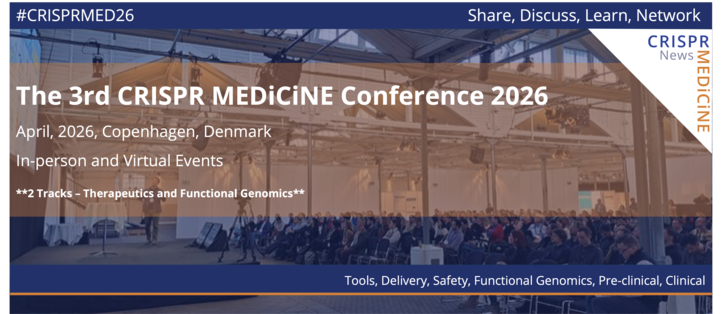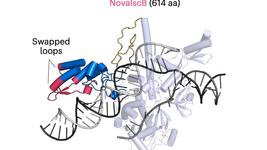CMN Weekly (30 June 2023) - Your Weekly CRISPR Medicine News
By: Gorm Palmgren - Jun. 30, 2023
Top picks
- Unpublished research presented at a conference this week warns that CRISPR-Cas9 gene editing in early human embryos could have unexpected and dangerous consequences because the embryonic cells are often unable to repair damage to their DNA. A press release from the 39th annual meeting of the European Society of Human Reproduction and Embryology (ESHRE) reports that Nada Kubikova from the University of Oxford (UK) detected alterations at the targeted DNA sites in 24 out of 25 embryos. However, only 9% of targeted sites were repaired using the clinically useful homology-directed repair (HDR) process, and 51% of broken DNA strands underwent nonhomologous end joining (NHEJ). The remaining 40% of broken DNA strands failed to be repaired. The unrepaired breaks led to large pieces of chromosomes being lost or duplicated. If affected embryos were transferred to the uterus and produced a baby, they would carry a risk of severe congenital abnormalities. Other scientists have commented on the research, and some point to the possibility of using less intrusive gene-editing techniques like base or prime editing instead of CRISPR-Cas9.
- Microbes are not the only organisms with programmable gene-editing enzymes, according to a new study led by Feng Zhang at the Broad Institute of MIT and Harvard. The researchers have uncovered the first programmable RNA-guided system in eukaryotes, namely the microscopic fungus Spizellomycespunctatus. It is based on a protein called Fanzor and can be reprogrammed to edit the genome of human cells. Because Fanzor systems are compact, they are easier to deliver to cells and tissues than CRISPR-Cas systems. With improved targeting efficiency, they become a valuable asset in the human genome-editing toolbox.
Research
- A Belgium study fuels the discussion on double-strand break repair in early human embryos. The authors targeted human embryos with CRISPR-Cas9 to correct a heterozygous base-pair substitution in PLCZ1 related to infertility. In 36% of the targeted embryos, only wild-type alleles were observed. The integrity of the targeted chromosome (i.e. no deletions larger than 3Mb or chromosome loss) was confirmed in all seven targeted and analysed embryos (mutant editing and absence-of-mutation), while short-range loss of heterozygosity (LOH) events (shorter than 10 Mb) were observed in two of these embryos.
- Danish and American researchers have used directed evolution to interrogate and optimise CRISPR-Cas guide RNA scaffolds. The authors observe that particular variants partner more effectively with specific DNA-binding antisense domains, yielding combinations with enhanced editing efficiencies at various target sites.
- Researchers in Singapore show that adeno-associated virus- (AAV-) delivered CRISPR-Cas13 can directly target and eliminate the positive-strand EV-A71 RNA virus in cells and infected mice. Treatment with a pool of AAV-CRISPR-Cas13-gRNAs effectively blocked viral replication and reduced viral titers in cells by >99.99%.
- Researchers in The Netherlands have shown that Cas12b can achieve complete HIV inactivation with only a single gRNA, something Cas9 requires two gRNAs for. Cas12b generates "hypermutated" HIV proviruses more likely to be defective due to mutation of multiple essential parts of the HIV genome. When the Cas12b system is programmed with two antiviral gRNAs, the overall anti-HIV potency is improved and generates more grossly mutated HIV proviruses.
- In a not-peer-reviewed publication, Chinese scientists have engineered CRISPR(a/i) tools containing heat-sensitive genetic modules controllable by focused ultrasound (FUS) to regulate the genome and epigenome in live cells and animals. The system is demonstrated to upregulate, repress, and knock out exogenous and endogenous genes in different cell types.
- In another not-peer reviewed publication, researchers from The Netherlands demonstrate the use of the amphipathic cell-penetrating peptide LAH5 for intracellular delivery of Cas9:sgRNA ribonucleoprotein (RNP) and RNP/single-stranded homology-directed repair (HDR) template. Targeted gene editing of the CCR5 gene was demonstrated in various cell lines with the new delivery system.
- Researchers in Thailand report a CRISPR genome editing platform, by the electroporation of Cas9 ribonucleoproteins and synthetic DNA repair templates, to enable rapid and precise genetic modifications of primary human microglia, for which a robust genetic method has been lacking. Genes implicated in the regulation of amyloid beta and glioblastoma phagocytosis in microglia were targeted with high gene-editing efficiencies for single (>90%) and double (>70%) knockout without detectable off-target editing.
Industry
- Sangamo Therapeutics and Voyager Therapeutics have entered a license agreement for epigenetic regulation treatment of prion disease. The agreement will leverage Sangamo's zinc finger transcriptional regulators (ZF-TRs), which it believes can specifically and potently block expression of the prion protein, and Voyager's capsid delivery TRACER™ platform that has been shown to effectively cross the blood-brain barrier when delivered intravenously in animal models.
- Prime Medicine and Cimeio Therapeutics announce a research collaboration to improve the safety and effectiveness of hematopoietic stem cell (HSC) transplants to treat genetic diseases, acute myeloid leukaemia (AML), and myelodysplastic syndrome (MDS). The collaboration will utilise Prime Medicine's Prime Editing platform and Cimeio's Shielded Cell and Immunotherapy Pairs (SCIP) platform.
- Vertex Pharmaceuticals and Lonza have agreed to build a dedicated manufacturing facility for type 1 diabetes cell therapies using the engraftment of stem cell-derived, fully differentiated insulin-producing islet cells. In one approach, Vertex's hypoimmune program, the same cells are edited to cloak them from the immune system.
- Synthego and ATCC (non-profit global biological materials and standards resource centre) have announced an alliance for cutting-edge gene editing of mammalian and mouse cell lines. Leveraging Synthego's innovative CRISPR solutions and ATCC's vast cell line collection, the collaboration will facilitate the expedited delivery of genome-edited cell lines tailored explicitly for drug discovery applications.
Detection
- Chinese researchers have developed a system for the unamplified and label-free detection of high-risk-human papillomavirus type 16 HPV16 DNA using CRISPR-Cas12a-functionalized solution-gated graphene transistors. The system can detect HPV16 DNA without amplification and labelling with a limit of detection (LOD) of 8.3×10−18 M within 20 min.
- A new surface plasmon resonance-based fibre tip (CRISPR-SPR-FT) biosensor uses CRISPR-Cas12a for amplification-free monkeypox virus detection and genotyping. The compact CRISPR-SPR-FT biosensor, measuring 125 μm in diameter, offers high stability and portability. In less than 1.5 h, it can detect double-stranded DNA from the pox virus with a limit of detection below 5 aM in plasmids and about 59.5 copies/μL in pseudovirus-spiked blood samples.
- Researchers in China have developed a new CRISPR-Cas13a-based electrochemical biosensor strategy to detect the SARS-CoV-2 RdRp gene. The system uses DNA entropy-driven technology to activate CRISPR-Cas13a and triple-stranded nucleic acids, and it has a detection limit of 90 aM.
Screens and target discovery
- Revolutionising drug discovery: The role of CRISPR gene editing in target validation. This SelectScience editorial discusses how researchers use innovative gene editing techniques to uncover new drug targets.
Reviews and commentaries
- The role of CRISPR in microbiome engineering breakthroughs. This article explores the applications of CRISPR in microbiome engineering and how it can overcome the bottleneck of human microbiome research.
- Integration of CRISPR-Cas with functional nucleic acids as a versatile toolbox for non-nucleic acid target diagnostics: a review. This review emphasises the technical tricks of integrating CRISPR-Cas systems and functional nucleic acids (FNAs), comprising aptamers and nucleic acid enzymes, for non-nucleic acid targeting diagnostic applications.
- Progress and Perspective of CRISPR-Cas9 Technology in Translational Medicine. This review presents the latest CRISPR-Cas9 technology achievements and prospects for translational medicine advances. The focus is on recent pre-clinical and clinical research directions, the construction of disease models, disease-related gene screening and regulation, and disease treatment and diagnosis for multiple refractory diseases.
Huh, heh, wow
- Pairwise, a pioneering food startup, has introduced the first CRISPR-edited food product to the US market. The Conscious Greens Purple Power Baby Greens Blend is a mix of colourful leafy greens with a unique, fresh flavour and up to double the nutrition of romaine salad, in which CRISPR technologies have been used to improve taste and nutrition.
- To understand evolution, American researchers have used CRISPR screens to reveal distinct genetic dependencies in human and chimpanzee stem cells and identify human-specific features. The team found that genetic differences tended to fall on lysosomal signalling pathways and cell-cycle progression pathways.
To get more of the CRISPR Medicine News delivered to your inbox, sign up to the free weekly CMN Newsletter here.
Tags
CLINICAL TRIALS
Castration-Resistant Prostate Cancer, CRPC, and Salivary Gland Cancer, SGC, (NCT04249947)
Sponsors:
Poseida Therapeutics, Inc.
Sponsors:
Poseida Therapeutics, Inc.
IND Enabling
Phase I
Phase II
Phase III
IND Enabling
Phase I
Phase II
Phase III
IND Enabling
Phase I
Phase II
Phase III







